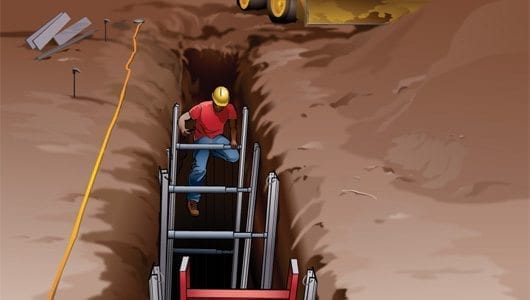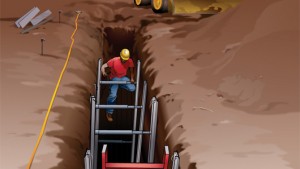
Reduce the risk of trench cave-ins
Trench cave-ins pose the greatest risk on a construction site and are much more likely than other excavation-related accidents to result in fatalities. While most trench cave-ins can be prevented by planning, many contractors still fail to perform this critical step to reduce the risk of trench cave-ins.
Why trenches fail
The Occupational Safety & Health Administration (OSHA) defines a trench as a narrow excavation made below the surface of the ground that is deeper than it is wide and not wider than 15 feet.
The most common reason for a trench cave-in is soil sliding, which is typically caused by pressure generated by the surrounding soil. Sliding can also be induced by excessive vibrations in the area, such as from heavy equipment and trucks. Heavy loads in the surrounding area, such as heavy materials or large spoil piles, can be too heavy for the soil to support, resulting in a cave-in. Other factors that can contribute are inadequate compaction of soils and close proximity to another trench. If cracks are visible in rocky soil, sliding has already occurred.
Water can also contribute and trenches excavated below the natural water table in sandy soils and soft clay are highly susceptible to heaving when seepage at the bottom of the trench causes soil to be pushed upward. Heaving is a warning signal that a cave-in may be developing. Water at the bottom of a trench can also begin to bubble. The soil rises, creating a quicksand-like – another warning of cave-in.
Changes in weather can change the pressure exerted on the trench. Excess water from rain or melting snow can undermine the stability of a trench wall and lead to cave-in. Inspect the site daily at the start of each shift, following a rainstorm or dramatic weather change, or after any other hazard-increasing event.
Understanding soil
A general understanding of the properties of soil is the first step in preventing cave-ins. The texture of soil is critical to its stability. Cohesive soil particles are less likely to crumble. Soil at a job site is usually a mixture of soil types:
- Clay – A finely grained soil. In general, rainfall will collect on the surface and evaporate rather than being absorbed.
- Sand – A granular soil. Sandy soils tend to have large pores, allowing faster groundwater absorption.
- Silt – Soil with properties of both sand and clay. Silt is the most sensitive to moisture and crumbles with drying.
Protection in the trench
A variety of methods can be used to protect workers in trenches.
Sloping and benching can be effective in preventing cave-ins, but are not always possible because the trench must be sloped on both sides, and wider excavation can damage an adjacent structure or expose utilities. The angle required to slope a trench varies with the soil type. If you use this method, be sure spoil is placed 2 feet or more from the edge of the trench and prevented from falling into the excavation by retaining devices. For benching, the type of soil determines the horizontal to vertical ratio of the benched side. As a rule, the bottom vertical height of the trench should not exceed 4 feet for the first bench and 4 to 5 feet for subsequent benches.
Shoring protects workers by preventing soil movement. Spaced sheeting or spot shoring, combines vertical planks around the boundary of the trench with horizontal braces that extend between the planks to support the sheeting. The trench braces can be wooden or metal, although metal braces are typically used when the trench width exceeds 5 feet. When the soil is unstable, closed sheeting should be used to support the entire trench wall. This can be done by installing continuous sheeting that extends the full depth of the trench.
Hydraulic shoring uses a prefabricated strut and/or wale system of aluminum or steel. Many contractors prefer hydraulic shoring to timbers because it is light enough to be installed by one worker, it is gauged to ensure even distribution of pressure along the trench face, and it can be easily adjusted to various depths and widths. Check hydraulic shoring at least once per shift for leaking hoses or cylinders, broken connections and any other damaged or defective parts.
Pneumatic shoring works much like hydraulic shoring, but uses air pressure instead of hydraulic fluid to expand the jacks into position. Pins lock the jacks in position. Another method of shoring uses screw jacks, which are adjusted manually. This creates a hazard because the worker must be in the trench to adjust the strut.
Regardless of type, shoring should be installed from the top down and removed from the bottom up.
- Trench boxes are designed specifically to protect workers from cave-ins. After the trench box is placed in position, the space between the box and the trench face is backfilled to prevent lateral movement of the box.
If a cave-in occurs
In case of an emergency, workers must be able to leave the trench quickly. OSHA regulations require that trenches more than 4 feet deep have adequate means of exit, such as a ladder or steps within 25 feet. OSHA also requires contractors to reduce the risk of cave-ins by limiting the number of workers in the trench at all times.
Cave-ins happen with little or no warning, resulting in injury or death. Most cave-in fatalities occur in trenches less than 12 feet deep and 6 feet wide. Since 2 cubic yards of soil weighs as much as a full size SUV, a victim buried under 2 feet of soil will have 700-1,000 pounds concentrated on the chest and back making breathing impossible. It is unlikely a victim will survive more than three to four minutes.
If a cave-in occurs, immediately call Emergency Rescue Services in the area. Never attempt to pull a partially buried victim out; instead dig by hand to free the victim. Do not use heavy equipment.
In addition to protection from cave-ins, OSHA requires contractors train workers in the hazards associated with trenching. OSHA offers a variety of resources in Spanish on the dangers of working in trenches and the most effective means of protection. Visit www.osha.gov or call (800) 321-6742.
The National Association of Home Builders’ (NAHB) “Trenching and Excavation Safety Handbook” and “Excavation Safety” video are available in Spanish. Order at www.BuilderBooks.com or call (800) 223-2665.
Reduce the risk of trench cave-ins
- Remove surface debris near the trench that could be a hazard.
- Check weather conditions for the construction period.
- Examine particle sizes of excavated soil to determine if it holds together.
- Look for layers of different soil types that may indicate instability.
- Look for water seeping from the sides of the trench.
- Look for signs of previously disturbed soil from other construction work.
- Look for cracks or fissures in the area.
- Consider vibration from equipment or vehicle traffic near the site.
- Examine the stability of adjacent structures.
- Plan how workers will enter and exit the trench.
- Develop an emergency response plan.


